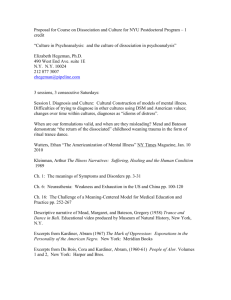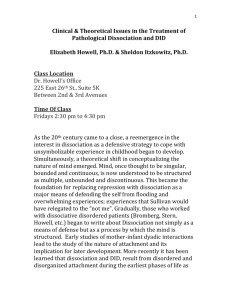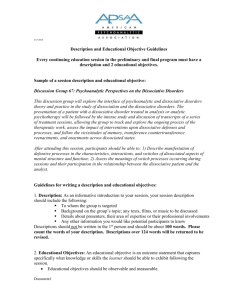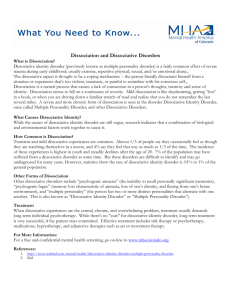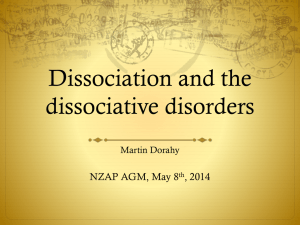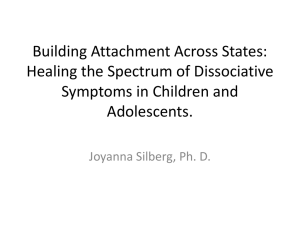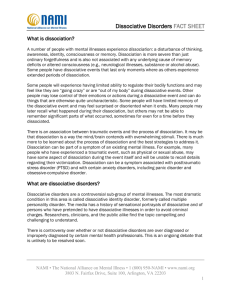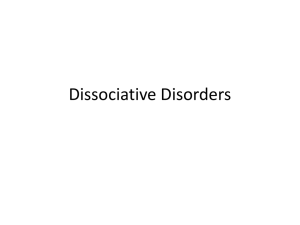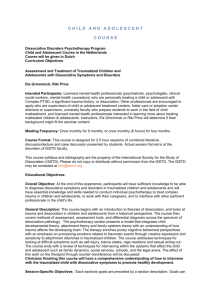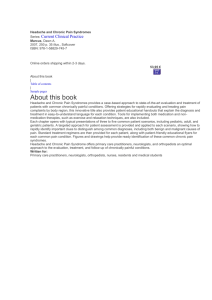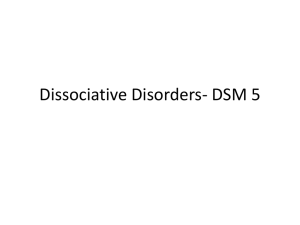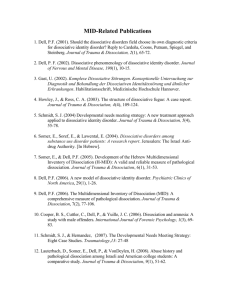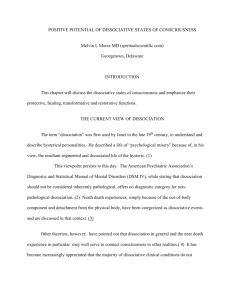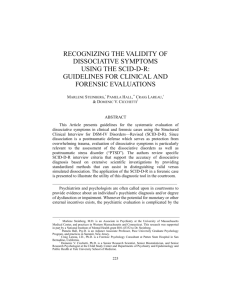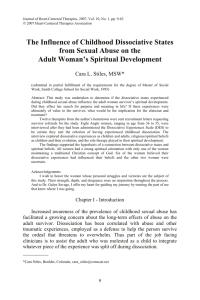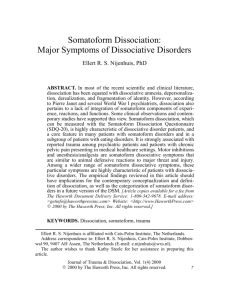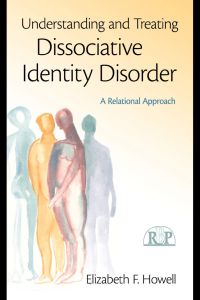Paraphrase and condensation of Boddy, Janice (2007)
advertisement
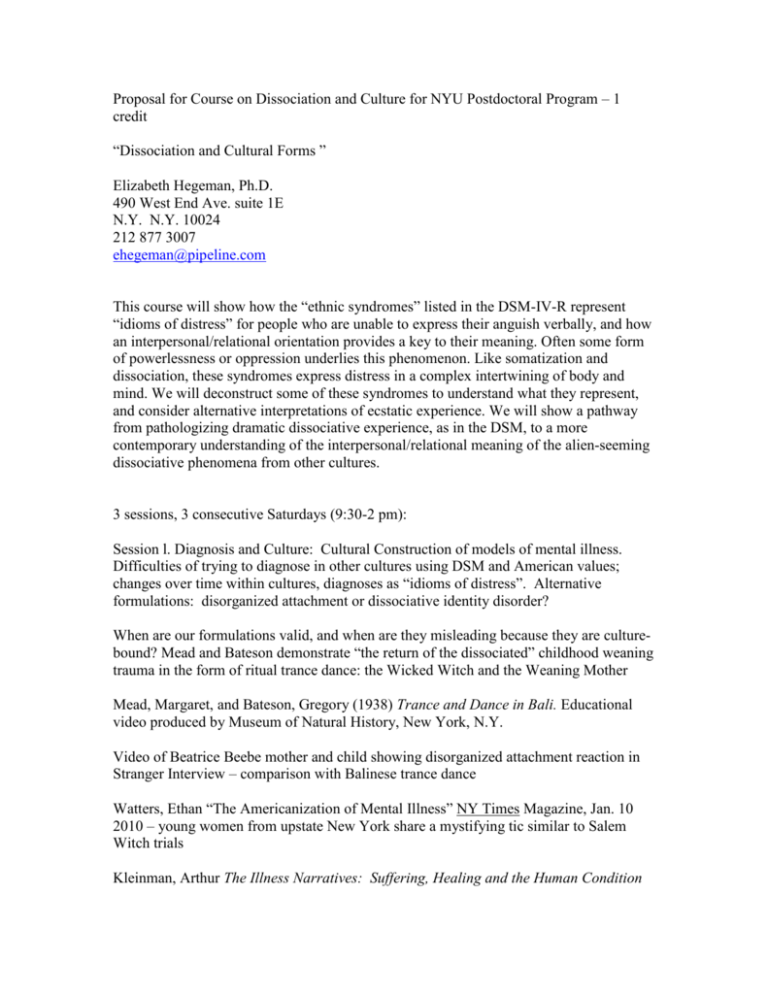
Proposal for Course on Dissociation and Culture for NYU Postdoctoral Program – 1 credit “Dissociation and Cultural Forms ” Elizabeth Hegeman, Ph.D. 490 West End Ave. suite 1E N.Y. N.Y. 10024 212 877 3007 ehegeman@pipeline.com This course will show how the “ethnic syndromes” listed in the DSM-IV-R represent “idioms of distress” for people who are unable to express their anguish verbally, and how an interpersonal/relational orientation provides a key to their meaning. Often some form of powerlessness or oppression underlies this phenomenon. Like somatization and dissociation, these syndromes express distress in a complex intertwining of body and mind. We will deconstruct some of these syndromes to understand what they represent, and consider alternative interpretations of ecstatic experience. We will show a pathway from pathologizing dramatic dissociative experience, as in the DSM, to a more contemporary understanding of the interpersonal/relational meaning of the alien-seeming dissociative phenomena from other cultures. 3 sessions, 3 consecutive Saturdays (9:30-2 pm): Session l. Diagnosis and Culture: Cultural Construction of models of mental illness. Difficulties of trying to diagnose in other cultures using DSM and American values; changes over time within cultures, diagnoses as “idioms of distress”. Alternative formulations: disorganized attachment or dissociative identity disorder? When are our formulations valid, and when are they misleading because they are culturebound? Mead and Bateson demonstrate “the return of the dissociated” childhood weaning trauma in the form of ritual trance dance: the Wicked Witch and the Weaning Mother Mead, Margaret, and Bateson, Gregory (1938) Trance and Dance in Bali. Educational video produced by Museum of Natural History, New York, N.Y. Video of Beatrice Beebe mother and child showing disorganized attachment reaction in Stranger Interview – comparison with Balinese trance dance Watters, Ethan “The Americanization of Mental Illness” NY Times Magazine, Jan. 10 2010 – young women from upstate New York share a mystifying tic similar to Salem Witch trials Kleinman, Arthur The Illness Narratives: Suffering, Healing and the Human Condition Hegeman course p. 2 Kleinman Ch. 1: The meanings of Symptoms and Disorders pp. 3-31 Ch. 6: Neurasthenia: Weakness and Exhaustion in the US and China pp. 100-120 Ch. 16: The Challenge of a Meaning-Centered Model for Medical Education and Practice pp. 252-267 Excerpts from Kardiner, Abram (1967) The Mark of Oppression: Explorations in the Personality of the American Negro. New York: Meridian Books Excerpts from Du Bois, Cora and Kardiner, Abram, (1960-61) People of Alor. Volumes 1 and 2, New York: Harper and Bros. Session 2. Ethnic Syndromes: from nonsense to sense In this session, we will show the relational meaning of three ethnic syndromes: zar, latah, and ataque or Puerto Rican Syndrome. These each have important distinctive culture history but share common themes of gendered oppression, and the symptoms convey protest over oppression and establish bonds of support. Youtube videos of latah “Ethnic Syndromes as Disguise for Protest against Colonialism: Three Ethnographic Examples” http://www.tandfonline.com/doi/abs/10.1080/15299732.2013.724340 “Latah: an ethnic syndrome with dissociative features—a sadomasochistic pattern?” chapter from Dissociation and Psychoanalysis by Elizabeth Howell and Shelly Itzkowitz, in press Paraphrase and condensation of Gherovici, Patricia (2003) The Puerto Rican Syndrome. New York: Other Press Paraphrase and condensation of Boddy, Janice (2007) Civilizing Women: British Crusades in Colonial Sudan. Princeton U. Press Excerpts from Simons, Ronald C.(1996) Boo! Culture, Experience, and the Startle Reflex Oxford U. Press Hegeman course p. 3 Discussion of Culture and Panic Disorder by Devon Hinton and Byron Good, Stanford U. Press 2009 Session 3 Spirit Possession, Dissociation, and Abuse: the interrelationships. A closer examination of the self-definition and the self-states involved in culturally structured dissociative roles. Cultures accept or reject the fluid vs. the bounded self; trance, doublebind in relationship, and the status of the shaman-healer. Role of healer as a solution to gendered role conflicts. Brief examination of the False Memory controversy and the role of culturally structured beliefs. Garrison, Vivian (1977) in Case Studies in Spirit Possession. (Ed.) Vincent Crapanzano. New York: Wiley-Interscience “The Case of Maria” Clinical examples from Harvey, Youngsook Kim (1979) Six Korean Women: the Socialization of Shamans. American Ethnological Society monograph # 65. New York: West Group Clinical examples from Kendall, Laurell (1987) Shamans, Housewives, and Other Restless Spirits. Honolulu: U. of Hawaii Press Petrucelli, Jean ed. Knowing and Not Knowing, Chapters by Itzkowitz, Hegeman, and Howell Excerpts from Young, Allan The Harmony of Illusions: The Invention of Post-Traumatic Stress Disorder Howell, Elizabeth F. Understanding and Treating Dissociative Identity Disorder Routledge
